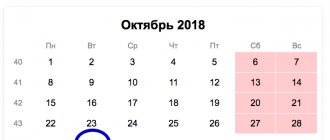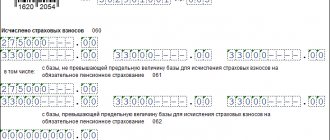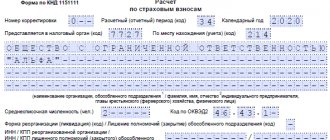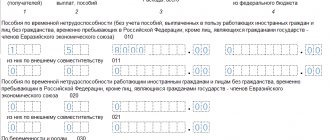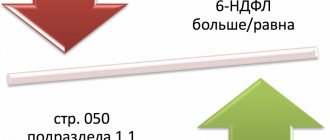Current legislation obliges all organizations and individual entrepreneurs that have employees to pay contributions for them for the purposes of compulsory pension, medical and social insurance. In addition to making actual payments, employers are also required to submit reporting documents on a timely basis.
Previously, when contributions were administered by the Pension Fund of Russia and the Social Insurance Fund, respectively, there were a large number of forms of reporting documents, and quite often certain changes were made to them. In 2021, insurance premiums are administered by the Federal Tax Service, and the reporting form is unified and unified (DAM).
Despite this, when filling out this document, the employer may make mistakes that require either submitting the report again or making adjustments to the calculation of insurance premiums. The features of the latter will be discussed in the article below.
If employee data does not need to be adjusted
In this case, the report includes only data on the organization with the adjustment number on the title page. There is no need to include employee data in the report. To remove employees from the report, uncheck them in Section 3.
If Section 1 is in automatic calculation mode, be sure to update the list of employees. For example, Kontur.Extern calculates amounts for all employees in the list, regardless of whether they are selected or unchecked. Check the box only for those employees who should be included in the adjustment report.
Also, in some systems, for example in Externa, amounts for employees and for the organization are reconciled only in the original report. To check the adjustment, use the following algorithm.
Algorithm for checking a corrective report
- Remove the correction number from the title page, if it is there.
- Update the list of employees in Section 3.
- Set the fields in Section 1 applications to automatic mode.
- Check the relevance of the data in previous periods.
- If the data is not up to date, download reports in pre-import mode into the service.
- Run the scan. Correct errors if any.
- Put the correction number on the title page.
- Generate and send a report.
If you report through Kontur.Extern, the task is simpler. The system will warn you if you try to send a report with the details of a previously sent report. Here are some tips:
- If the Federal Tax Service has accepted the initial report and you want to send an adjustment, the system will tell you which number you need to indicate.
- If the initial report has not yet been accepted, Extern will inform you that it is too early to send the adjustment and will advise you to wait for a response from the Federal Tax Service.
- If the primary report is rejected, Extern will warn you that before sending the adjustment you must submit the primary report with number = 0.
Reporting through another system? Connect to Extern with a 50% discount (not valid in all regions).
Catch a discount
In what form should the updated calculation be submitted?
The updated calculation is submitted in the form that was in force during the billing period for which changes are made (Part 5, Article 17 of Law No. 212-FZ). So, if an accountant identifies an error in the calculation for the first quarter of 2015, then the “clarification” should be drawn up according to the RSV-1 form, which was in force in the first quarter of 2015 (approved by Resolution No. 2p). And if, for example, you need to correct the individual information of the insured persons for the years 2010-2013, then you will have to fill out the “old” forms SZV-6-1, SZV-6-2 or SZV-6-4 and accompany them with the corresponding inventories (clause 17.9 Procedure for filling out RSV-1).
Let us separately dwell on the question of what form to use to draw up an updated calculation for the first half of 2015. Let us recall that during the reporting campaign for the half-year there was confusion with the RSV-1 forms (for more information, see “New RSV-1 form: features of filling out and submitting calculations for the first half of 2015”). Before August 7, 2015, when Resolution No. 194p came into force, which approved the new form RSV-1, many policyholders managed to report using the “old” form in force at that time. What form should be used in this case to clarify the calculation for the half-year? If we are guided by Part 5 of Article 17 of Law No. 212-FZ, then the updated calculation must be submitted in the “old” form (that is, in the same form in which the primary calculation was submitted). However, we do not rule out that the territorial bodies of the Pension Fund of the Russian Federation may require the submission of “clarifications” for the first half of the year using the new form, since Resolution No. 194p applies “starting with the submission of calculations for the first half of 2015.” In this regard, if the policyholder reports “on paper”, then it is better to check in advance with your Pension Fund department about what form to use to draw up the “clarification”.
If the policyholder submits payments electronically, then there should be no problems with choosing the form. In modern web services for preparing and submitting reports (for example, in the Kontur.Extern service), the program will automatically generate updated reports in the required format, which will be accepted by the fund without refusal. The accountant will only need to enter the correct data into the form provided by the service.
If you need to adjust data on employees in Section 3 (except for full name and SNILS)
On the title page, indicate the correction number (for example, “1—,” “2—,” and so on). According to the filling procedure, include in the form only those employees for whom you need to correct the data.
For each employee, indicate the adjustment number, keeping the serial numbers. Unused numbers can be added to new employees.
Please note: checks in the service work for all employees only if the title has an adjustment number = 0. To check the report, use the above algorithm.
Please indicate the correction number on the title page. For example, “1—”, “2—”, etc. Then create two employee cards and send them in one calculation:
- With incorrect SNILS, zero (deleted) Subsection 3.2 and adjustment number “1”. In lines 160-180, indicate the sign “no”.
- With the correct SNILS, correct amounts in Subsections 3.2.1 and 3.2.2, adjustment number “0” and a new serial number of the employee (not previously used).
If the error in the full name and SNILS was formatted and last quarter it was possible to send a report with it, but now it is not (for example, numbers and dashes in the full name, spaces at the end of the full name, incorrect SNILS), check with the inspector what to do.
Example 1: SNILS is not the same, but real
In the original report, instead of Ivanov Ivan Ivanovich working in the organization with SNILS 001-001-002 13, Ivanov Ivan Ivanovich with SNILS 001-001-001 12 was indicated. Both SNILS numbers exist and can be loaded into the Federal Tax Service database.
To prepare the adjustment, we create two employee cards. The first is with an error that needs to be corrected, the second is with data that should be in the report.
On the first card in Section 3, tick Ivanov Ivan Ivanovich with SNILS number 001-001-001 12. In his card:
- Specify a non-zero adjustment number;
- In lines 160-180, mark “No”;
- Remove section 3.2.
In the second card in Section 3, tick Ivan Ivanovich Ivanov with SNILS number 001-001-002 13. In his card:
- specify the correction number = 0;
- Fill in the correct information for the remaining positions.
Example 2: non-existent SNILS
In the original report, instead of Ivanov Ivan Ivanovich working in the organization with SNILS 001-001-001 12, Ivanov Ivan Ivanovich @ was indicated! with SNILS 001-001- 002 18.
Such SNILS should not pass the check for the control ratio, and the full name should not be checked according to the scheme. The Federal Tax Service should not have accepted such a report. If this happens, contact the inspector for clarification.
Introductory information
General provisions regarding changes in the calculation of RSV-1 are contained in Article 17 of Federal Law No. 212-FZ dated July 24, 2009 (hereinafter referred to as Law No. 212-FZ). The rules for drawing up and submitting updated calculations are directly spelled out in the Procedure for filling out the RSV-1 form, approved by Resolution of the Pension Fund of the Russian Federation of January 16, 2014 No. 2p (hereinafter referred to as Resolution No. 2p). Since August 7, 2015, this Procedure has been in effect in the wording approved by Resolution of the Pension Fund Board of June 4, 2015 No. 194p (hereinafter referred to as Resolution No. 194p). However, in practice, the new rules have been applied since June 29, 2015, when the Pension Fund of the Russian Federation updated its verification program. The application of these documents raises numerous questions. In what case do you need to submit a “clarification” on contributions, and what errors can be corrected in current reporting? What form should I use to make an updated calculation? What is the procedure for making clarifications? Can a “clarification” get rid of a fine? Let's figure it out.
If you forgot to include an employee in the original report
Include the forgotten employee in the adjustment form with the adjustment number in the employee card = 0. The amounts in Section 1 and Appendices 1 and 2 to Section 1 change taking into account this employee and are indicated as they should be throughout the organization).
Please note that each time you send a new correction, you must put a new number on the title page.
Report for employees through Kontur.Extern. Loading data into RSV from SZV-M. Importing data from 2-NDFL 5.06. Zero RSV in no time. Free for 3 months.
Register
Submission deadlines
If violations are found in the submitted calculation, then the DAM reporting will have to be resubmitted on time - no later than the 30th day of the month following the reporting quarter. The tax office allows the submission of the corrected calculation before this deadline (clause 2 of Article 81 of the Tax Code of the Russian Federation). Submitting in violation of the deadline will result in penalties and fines: tax authorities mark the report as not submitted.
If the inspector discovers a violation after submitting the calculation of insurance premiums, he informs the taxpayer about it. Errors must be corrected within 5 working days, the period is counted from the date of sending the electronic notification (clause 7 of Article 431 of the Tax Code of the Russian Federation). For paper notifications, different deadlines are established - 10 business days from the date of sending.
IMPORTANT!
Calculate and pay penalties and arrears before submitting the updated calculation (Article 75 of the Tax Code of the Russian Federation). If the tax authorities receive clarification earlier than the payments, they will impose a fine for paying insurance premiums in an incomplete amount (Article 122 of the Tax Code of the Russian Federation).
What happens if you're late
If corrections are sent untimely, the Federal Tax Service will impose a fine and oblige you to pay penalties and arrears. The fine ranges from 5 to 30% of the amount of social contributions, but not less than 1,000 rubles (Clause 1 of Article 119 of the Tax Code of the Russian Federation). In some cases, the tax office blocks the accounts of violators.
If you included one employee instead of another
Both employees must be included in the corrective report:
- Unnecessary - with zero (removed) Subsection 3.2 and adjustment number “1”. In lines 160-180, indicate the sign “no”.
- Required - with correct data, correct amounts in Subsections 3.2.1 and 3.2.2 and adjustment number “0”.
Section 1 with Subsections 1 and 2 needs to be adjusted: subtract the amounts of the erroneously added employee from the total amounts of the organization and add the amounts for the employee who was forgotten to be included.
Common mistakes when calculating additional insurance premiums
Any shortcomings can be detected both independently and during an inspection (reconciliation). Typical errors: incorrect application of insurance rates, false accrual of taxable profits, inaccurate indication of disability data, etc.
Correction of errors is described in detail in PBU 22/2010. Minor miscalculations made in past periods and identified after the submission of financial statements are corrected in the month in which they were discovered. For this purpose, proper accounting entries are made, and the resulting income (damage) is shown as part of other profits (expenses) of the reporting period (from account 91).
For example, an employer awarded benefits to an employee based on a false medical certificate. The erroneous accrual on the fake sick leave was not discovered immediately, but after some time. The payment was made in violation, therefore, the FSS will not accept it for credit. Additional insurance charges will be made on the amount itself.
A number of errors may be associated with unreasonable additional assessment of contributions. The law stipulates that compensation, financial assistance, and social benefits are not subject to insurance fees (Tax Code of the Russian Federation, Article 422). Contributions are calculated only from payments provided for under labor and civil law agreements; in other cases, calculations (additional accruals) will be considered unfounded.
| Examples of payments in favor of an employee that are not included in the base for accrual (additional accrual) of insurance premiums | Reasons why contributions are not calculated (additionally accrued) from payments |
| Compensation by the employer for a trip to an employee for sanatorium-resort treatment on the basis of a collective agreement | The social nature of the payment provided for by the collective agreement; the compensation paid is not remuneration for work in accordance with the employment contract |
| Payment of fines for traffic violations by the head | The driver is an official in execution, and payment of a fine by the employer does not constitute a material benefit and is not income |
| Amounts spent on corporate events for employees provided for by the collective agreement | These expenses are not considered income under employment agreements. |
Thus, additional accrual (calculation) will be legal when it is supported by the relevant norms of the collective agreement and has a replenishing, compensating nature. In the listed situations, additional assessment of insurance premiums from amounts paid by the employer will be contrary to the law and considered erroneous.
If the right to apply a reduced tariff has been acquired/lost (recalculation of contributions from the beginning of the year)
In the clarifying calculations for previous reporting periods in Appendix 1, indicate the new tariff code (08/02). Change the contribution amounts in Section 1 and Appendices 1 and 2 to Section 1 to take into account the new tariff.
All employees must be included in the corrective report. In each employee’s card, indicate an adjustment number other than 0, maintaining the serial numbers of the employees. In Subsection 3.2.1 you need to indicate two categories of the insured person (NR and PNED):
- the old category with zero amounts.
- a new category with the correct amounts.
What is regulated
The procedure for filling out insurance premium calculations and making adjustments to reporting is strictly regulated. Here are the standards on the basis of which the calculation of insurance premiums is adjusted in 2021 and for previous periods:
- Tax Code of the Russian Federation - articles, 119, 431.
- Order of the Federal Tax Service No. ММВ-7-11/ dated September 18, 2019 for periods starting from 2020.
- Order of the Federal Tax Service No. ММВ-7-11/ dated October 10, 2016 for periods until 2021 (currently no longer in force).
Will prompt correction of individual information after an on-site inspection save the Pension Fund from a fine?
The article from the magazine "MAIN BOOK" is current as of February 6, 2015.
Contents of the magazine No. 4 for 2015 N.G. Bugaeva, economist
One of the violations for which an organization can be held accountable after an inspection by the Pension Fund is the unreliability of information in personalized reporting. 17 of Law No. 27-FZ dated 01.04.96 (hereinafter referred to as Law No. 27-FZ). But detection of unreliability by inspectors does not always lead to the company being required to pay a fine.
Everyone is accustomed to the fact that if, during the reporting campaign, the policyholder submits personalized information about employees with errors to their Pension Fund branch, then, having discovered this fact, the Fund’s specialists will respond by sending the organization a notification about the need to eliminate them. After this, the policyholder has 2 weeks to correct inaccuracies and re-send the reports to the Fund. And if the organization does not do this, then the Pension Fund itself will correct the information based on the data that it has. Such rules are established by the Instructions on the procedure for maintaining personalized records, and they fully comply with the requirements of Law No. 27-FZ that the policyholder has the right to supplement and clarify the transmitted individual information on the insured persons in agreement with the Fondomst. 15 of Law No. 27-FZ; clause 41 of the Instructions, approved. By Order of the Ministry of Health and Social Development dated December 14, 2009 No. 987n.
In addition, the Pension Fund of the Russian Federation expressed its position back in 2004: if the policyholder manages to correct the errors discovered by the Fund within 2 weeks, then sanctions for unreliability may not be applied to the organization. Letter of the Pension Fund of the Russian Federation dated December 14, 2004 No. KA-09-25/13379. In this regard, the question arises: does the Pension Fund have the right to fine an organization if, within the specified 2 weeks, it corrects errors in individual information identified during an on-site inspection?
FAS CO came to the conclusion that no. Since neither the Instructions nor the Pension Fund Letter mentioned above say that policyholders are exempt from the fine only if errors discovered during the reporting campaign are “timely” corrected. And if incorrect data was identified during an on-site inspection and clarified within 2 weeks, the same rules should apply, canceling sanctions Resolutions of the FAS Central District dated June 27, 2014 No. A48-3361/2013, dated August 5, 2014 No. A48-3324/2013. Moreover, the decisions of the judges were supported by the Supreme Court, which did not accept the case for reconsideration. In one case, the company submitted corrective personalized reporting within 2 weeks from the date of receipt of the on-site inspection report, which contained a proposal to submit corrected information. Decree of the Supreme Court dated September 30, 2014 No. 310-KG14-1896. In another case, the organization did not wait at all for any documents from the Pension Fund of Russia and sent adjustments even before the inspectors drew up the act of Determination of the Armed Forces dated November 24, 2014 No. 310-KG14-4558. By the way, arbitration courts in other districts came to similar conclusions; Resolution of the Federal Antimonopoly Service of the North Caucasus of 02.08.2012 No. A63-8401/2011; 4 AAS dated August 26, 2014 No. A19-7865/2014.
Moreover, some judges point out: since individual information, which initially contained errors and omissions, was then corrected in accordance with the procedure established by law, it can no longer be considered unreliable. Therefore, the Pension Fund of Russia did not have the right to “issue” a fine. Resolution of the AS ZSO dated November 7, 2014 No. A27-19661/2013; 4 AAS dated 01/09/2014 No. A19-10376/2013.
Of course, this opinion of the courts plays into the hands of policyholders. However, the arguments on which the judges' decisions are based have weaknesses. If you read the details of the mentioned Letter and evaluate the conclusions of the Pension Fund, without taking them out of context, it will become clear that the Fund gave such explanations, commenting on an absolutely specific case: correcting an error discovered by the territorial office of the Fund when accepting reports from the policyholder as part of a regular reporting campaign. Under such circumstances, it is pointless to point out that this Letter, despite its 10-year age, has not been canceled and is valid, because it, in fact, has nothing to do with the situation under consideration.
In addition, as stated above, the company must correct errors based on a notification from the Pension Fund. But based on the results of the on-site inspection, it is not a notification that is issued, but an act. 2 tbsp. 38 of the Law of July 24, 2009 No. 212-FZ. And although in the current form of the act there are lines where controllers can recommend that the policyholder make corrections to the reporting, the notification and the act are still different documents, form 17-PFR (Appendix No. 23 to Order of the Ministry of Labor dated November 27, 2013 No. 698n).
But in fairness, we note that judges ignore these points. This means that, if necessary, it certainly makes sense for policyholders to use the above judicial practice and confidently refer to it.
***
The Supreme Court agreed with the judges' logic discussed above. And this, of course, adds weight to the position. But in a dispute, a 100% guarantee of success cannot be given. After all, other courts come to different conclusions and note that it is impossible to cancel financial sanctions if the policyholder did not independently find an error in individual information, but the auditors did it for him during an on-site inspection. Resolution of the Orenburg Region AS dated October 30, 2013 No. A47-5281/2013 ( Attention! PDF format); AS of the Tomsk Region dated October 25, 2012 No. A67-5568/2012 (Attention! PDF format).
Other articles from the magazine "MAIN BOOK" on the topic "Reporting to the Pension Fund of Russia / reporting to the Social Insurance Fund":
2019
- How to correct an error in SZV-STAZH, No. 7
- SZV-STAZH for 2021, No. 4

